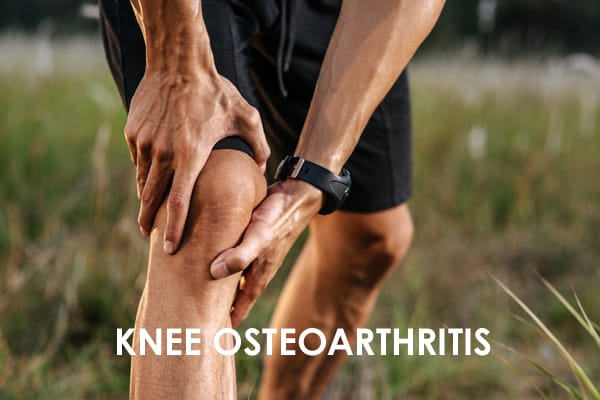Knee Osteoarthritis is a degenerative joint disease that is typically a result of wear and tear and cause progressive loss of the articular cartilage of the joint.
| Cause | Primary OA cause hasn’t been determined and is apparent without any apparent reason. Secondary OA is a result of having abnormal forces across the joint, maybe post-trauma/surgery |
| Common symptoms | Pain, stiffness, swelling, cracking sounds, joint enlargement |
| How is it diagnosed clinically? Diagnostically | Clinical diagnosis is a combination of multiple factors. Some factors include (older age, women>men, prior history of trauma/surgery, obesity, family history, joint positioning, metabolic causes). It can also be confirmed diagnostically by X-rays. There are various grades that are based on joint space narrowing, cartilage damage, osteophyte formation and subchondral changes |
| Treatment options? | The number 1 treatment option is conservative management (ie. Patient education, therapeutic exercise, activity modification, weight loss, bracing) Surgery should be considered after a conservative approach (talk to your orthopaedic specialist for more information) |
| How physiotherapy can help? | Physiotherapy can help by providing you with education about osteoarthritis, tailor an exercise program that is suitable for you, help you consider the best options for activity modifications, provide you with education on bracing, address psychosocial factors such as fear-avoidance, promote patient autonomy and get you back to doing the things you love to do! |
| Typical physiotherapy treatment approach-manual therapy, modalities, exercise, etc | Manual therapy- joint mobilisation to help with stiffness. Muscle energy technique to help stretch surrounding muscles.
Modalities- heat/ice for pain relief, TENs/IFC for pain relief and inflammation control. Ultrasound for pain relief.
Exercises- help with improving mobility, ROM, strength, balance, aerobic capacity, promoting physical function, reducing knee pain and inflammation. |
| Other treatment options | Medications to help with pian relief and reducing inflammation. (NSAIDs, COX2-inhibitors, Glucosamine chondroitin sulfate, corticosteroids, Hyaluronic acid) Bracing/Taping to help offload the joint Electrotherapy. Hydrotherapy |
| Prognosis | Osteoarthritis of any joint does not have a cure,however it doesn’t mean we can’t slow down the progression of OA and you can’t get back to doing everything you love. The prognosis for OA is generally pretty good if you participate in active recovery and are willing to make lifestyle changes that will be in your favour from a general health perspective. This will help with joint health and we can strengthen the surrounding musculature, as well as use braces or assistive devices to help with your recovery and prognosis. |
| Consequences of not getting it treated/long term effects | Some consequences of not getting treated is stiffness of the joint, increase in pain levels at rest, muscle atrophy, reduction in daily function, sleep maybe affected. All of these can potentially affect general health and overall quality of life. |
| Braces that can help | Off-loading braces- help shift load from the affected knee compartment Examples: Genutrain S, Genurtrain S Pro OA Lite, Clima-flex OA knee brace, OA adjuster, Custom Made Adjustable OA Defiance |
If you think you might have osteoarthritis of the knee, contact us to book an appointment with one of our Physiotherapists today!


